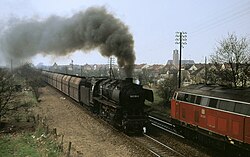Railway and locomotive engineering - a practical journal of railway motive power and rolling stock (1905) (14759671372)
Identifier: railwaylocomotiv18newy (find matches)
Title: Railway and locomotive engineering : a practical journal of railway motive power and rolling stock
Year: 1901 (1900s)
Authors:
Subjects: Railroads Locomotives
Publisher: New York : A. Sinclair Co
Contributing Library: Carnegie Library of Pittsburgh
Digitizing Sponsor: Lyrasis Members and Sloan Foundation
View Book Page: Book Viewer
About This Book: Catalog Entry
View All Images: All Images From Book
Click here to view book online to see this illustration in context in a browseable online version of this book.
Text Appearing Before Image:
il to the fire box is simple and inex-pensive. Ill the coal tender is an irontank with a capacity of 900 gallons ofoil. This will run the engine con-tinuously about forty-eight hours. Theoil passes through a pipe underneathI he lire box. the llow being regulatedby a le\ er within reach of ihe engineer.Before heiiii ejected intn iho fire box by nci means new. In Texas and Soutli-ern California nearly all loconiolivcs usefiil for fuel. In sections of the coun-try where coal is scarce the oil burneris common. The increased price of coalmay cause a larger use of oil as fuelfor locomotives. Report of the Interstate CommerceCommission. hrom the statistics i>i railways in theLnited Stales for the year ending Jupe.so, 1904, and which has just been pub-lished by the central bureau at Washing-inn, we learn that ihe total single-trackrailway mileage in the United Stateswas 213,904 miles, having increased 5,927mi.es during that year. This increaserxri <■v iliril of any previous year since
Text Appearing After Image:
CARNEGIE STEEI, COMPANY SWITCHING ENGINE. 51 ins., the wheel base being 11 ft. Thelength of the engine and tender is 41 ft.II ins., and the weight on the drivingwheels 145.120 lbs., which is the totalweight of the engine, the tank addingabout 91,000 lbs, in a total weight of en-gine and tender of 236.000 lbs. The capacity of the tank is 4,500 gal-lons. These engines, on account of thesmall diameter of their driving wheels,are of great tractive power; the abovedimensions at a working pressure of 200lbs. give a tractive power of 41,900 lbs. Oil-Burning Locomotives. Experiments which have been madenil the Frisco railroad system at Kan-sas City have successfully demonstratedthat oil-burning locomo.ives can be runcheaper ihin coal b-.irners. ^fr, GeorgeA. Hanenek. superinlenderi of mitive the oil is subjected to a heating processwhich makes it highly inflammable. Justbeneath the slot where it enters the firebox is a steam jet upon which the oildrops and is converted into a vapor thatburns
Note About Images
Relevante Bilder
Relevante Artikel
Ölfeuerung (Dampflokomotive)Dem Einsatz der Ölfeuerung in der Schifffahrt und bei ortsfesten Kesselanlagen folgte Ende des 19. Jahrhunderts die Entwicklung derartiger Feuerungsanlagen im Lokomotivbau. .. weiterlesen





